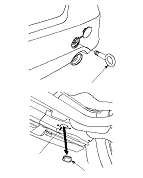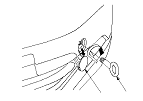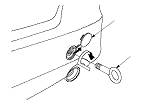Towing
|
If the vehicle needs to be towed, call a professional towing service. Never tow the vehicle behind another vehicle with just a rope or chain. It is very dangerous.
Emergency Towing
There are three popular methods of towing a vehicle.
Flat-bed Equipment −
The operator loads the vehicle on the back of a truck.
This is the best way of transporting the vehicle.
To accommodate flat-bed equipment, the vehicle is equipped with front towing hook (A), front tie down hook slots (B), rear towing hook (C), and the rear tie down hook slots (D).
The towing hook can be used with a winch to pull the vehicle onto the truck, and the tie down hook slots can be used to secure the vehicle to the truck.
NOTE: The tie down hook slots use rubber plugs (E) to cover the openings.
Towing Hook Installation
The detachable towing hook is for towing very short distance, such as freeing the car. The hook mounts to the anchor in the front and rear bumper.

|



